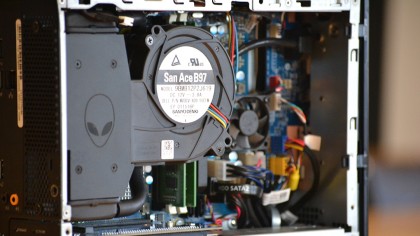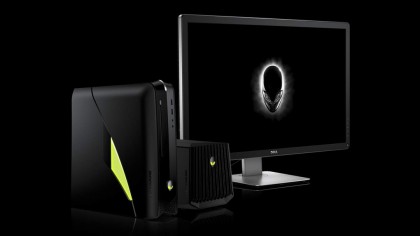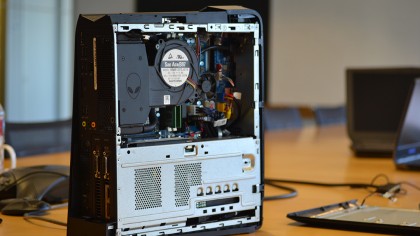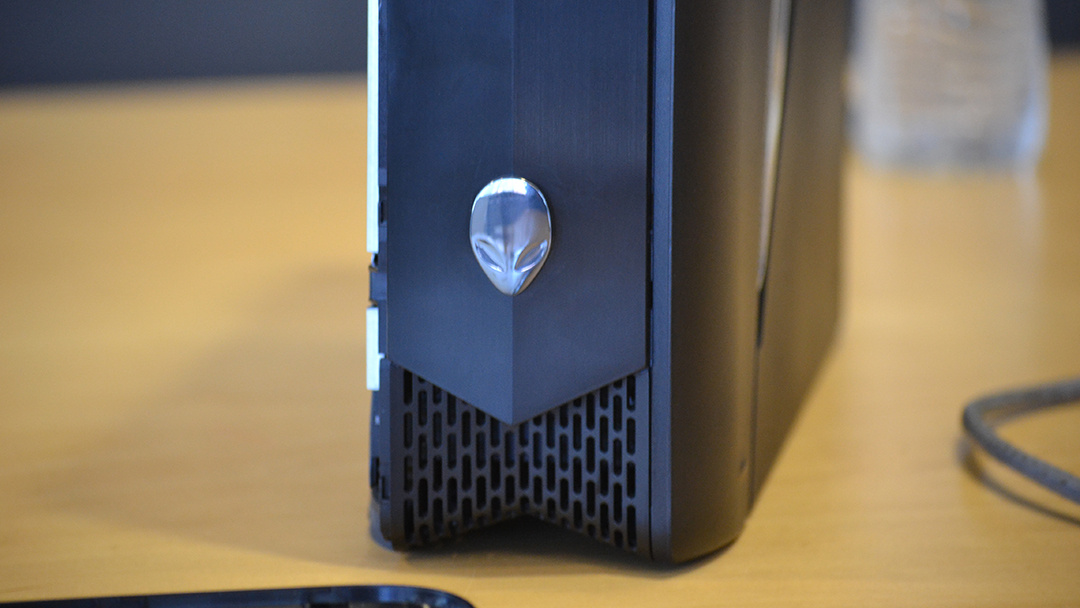Early Verdict
With a 6th generation Intel chips in tow, the revamped Alienware X51 has all the makings of a petite powerhouse. It's not without its shortcomings, but smart additions, like a M.2 PCIe slot and USB 3.1 ports inside a super clean build, make this rig worthy of your attention.
Pros
- +
New Skylake processors
- +
Space for SSD
- +
Alienware Graphics Amplifier expansion
Cons
- -
Proprietary motherboard
- -
Tough to upgrade
- -
Not the most powerful ITX system
Why you can trust TechRadar
When it launched back in June 2012, Alienware's original X51 system had all the merits of a Steam Machine without the title: It was small in stature and perfectly tuned for gaming in the livingroom.
Packing Ivy Bridge, the three year old model had a marked advantage over the much smaller crowd of mini-ITX options on the market. And while gamers lauded the system for its compact design, any attempt to overclock the system usually resulted in complete system failure.
Hot on the next iteration of Intel's processors, Alienware wasn't about to fall into the same pitfall again. And so, the firm has introduced a new line of X51 systems comes with a custom, miniaturized liquid-cooling solution, all starting at $1,099 (around £700, AU$1,500).
Decide you need even more power than what the premium micro system can offer? A port for the proprietary Alienware Graphics Amplifier unlocks the system's 4K capability with help from a GeForce Titan X or GTX 960 GPUs.

Design
Putting a PC against a console in terms of performance is like comparing a Ferrari to a Ford Fiesta. That is to say, there is no comparison. But, for the console-inclined, the new X51 measures in around the same size as an Xbox One (i.e. 13.5 x 12.5 x 3.7 inches or 343 x 318 x 95mm, H x D x W).
Inside the chassis you'll find hardware stacked on top of hardware in an immaculate build. The only space left is a small pocket of air in the top left corner of the machine where you'd most often find an optical drive.
Alienware intentionally decided to omit such a drive from the 51 for fear of compromising the thermal profile of the build. You'll find a removable tray for the GPU, which allows for single-width cards, and room for both an M.2 PCIe solid-state drive and a standard 3.5-inch hard drive. (Neither of which share the same data connection as the GPU, so the two won't ever cross paths and causing unnecessary congestion.)
Sign up for breaking news, reviews, opinion, top tech deals, and more.

The jewel of the build is the new custom CPU liquid cooler, which ditches the typical hoses and is a single block that combines the pump and radiator into one device. Supporting both 6th-gen Intel Core i5 and i7 processors, it liberates the system from the shackles of low-powered components without running the risk of frying the whole shebang.
The only downside I saw to the build was that the internals sat on a custom motherboard designed by Alienware. That might give gamers a reason to fret, as I see no feasible way to upgrade to another chipset down the road.

But it's hard to complain when the system comes standard with 8GB of dual channel DDR4 (2,133Mhz) memory. That's in addition to connections for the Alienware Graphics Amplifier,two USB 2.0, two USB 3.0, two USB 3.1, as well as 802.11ac and Bluetooth for wireless networking.
Overall, the system is neatly trimmed and intelligently built. A liquid cooled core means that heat dissipation shouldn't be a problem even when overclocking. Meanwhile, a removable tray for the GPU and drives should make changing out these components a cinch.

Performance
Thanks to the Intel Core i5-6600K (6MB cache, overclocked up to 4.3GHz) and 8GB of RAM that comes standard with every box, there's almost no reason that the X51 shouldn't excel as a gaming machine. Bumping up to a Core i7-6700K would net you even more power from the pint-sized system, but doing so comes at a premium.
In addition to the memory and processor options, the X51 will have three choices for GPUs at checkout: a GeForce GTX 745 with 4GB of DDR3 VRAM, an AMD Radeon R9 370 with 4GB of DDR5 memory or a GTX 960 with 2GB of DDR5. All of this will be powered by a 330-watt power supply and run on Windows 10.

If you decide you need more power, there's always the option to throw a GTX Titan X into Alienware's £199/$299 Graphics Amplifier. This route is less cost-effective than buying a desktop with such a card installed already, but the benefit is a lower-costing system upfront.
So, how does it compare to last year's system? The numbers provided by Alienware show a 20% increase in 3DMark Fire Strike scores when pitting the X51 equipped with an Intel Core i7-6700K processor last year's model with an Intel Core i7-4790. But we'll put those numbers and more to the test in a full review.

Early verdict
The Alienware X51 is a decent rival for smaller console-sized systems, like the still-en route Steam Machines. It provides plenty of power, thanks to the updated CPUs and DDR4 memory, and even provides fans of 4K an option with the optional Graphics Amplifier.
That said, I'm not completely sold. A proprietary motherboard doesn't bode well for future expandability. And while I dig the idea of plugging into a Titan X in the living room, it's a tough sell when it also requires an additional £199/$299 (around AU$418) adapter here. The proof of whether it's necessary will come through in my forthcoming full review.
The Alienware X51 with Skylake processors starts at $1,099 (around £700, AU$1,500), and are available to order starting on August 27.

Nick Pino is Managing Editor, TV and AV for TechRadar's sister site, Tom's Guide. Previously, he was the Senior Editor of Home Entertainment at TechRadar, covering TVs, headphones, speakers, video games, VR and streaming devices. He's also written for GamesRadar+, Official Xbox Magazine, PC Gamer and other outlets over the last decade, and he has a degree in computer science he's not using if anyone wants it.
What is a hands on review?
Hands on reviews' are a journalist's first impressions of a piece of kit based on spending some time with it. It may be just a few moments, or a few hours. The important thing is we have been able to play with it ourselves and can give you some sense of what it's like to use, even if it's only an embryonic view. For more information, see TechRadar's Reviews Guarantee.
